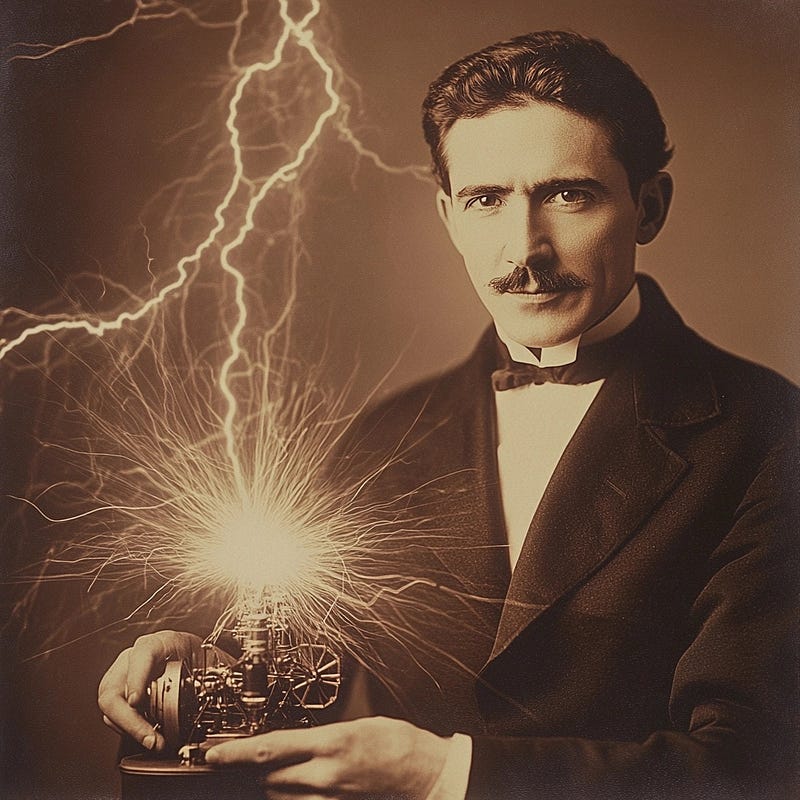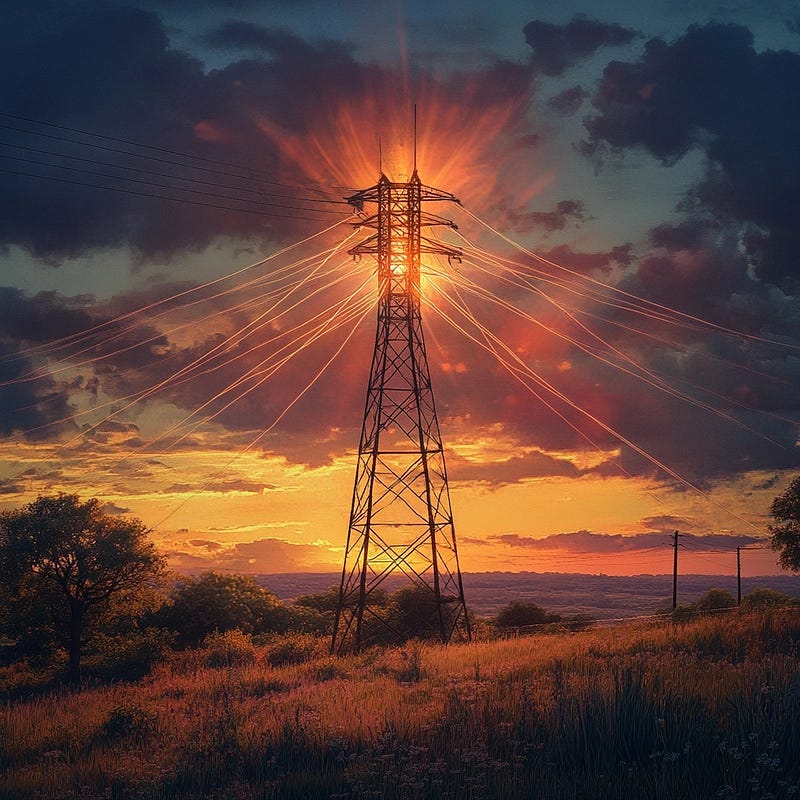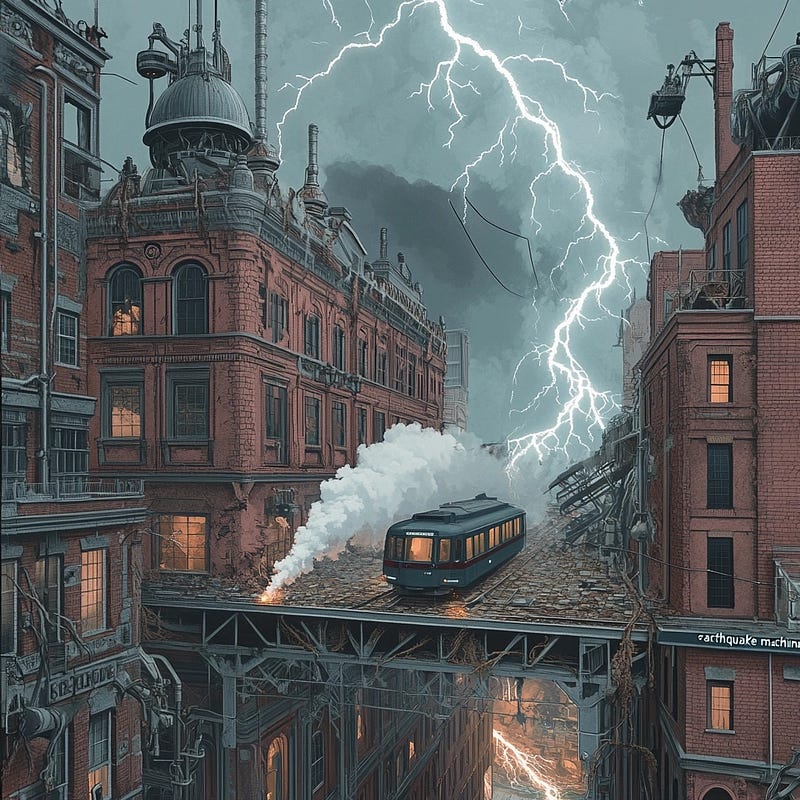The Timeless Genius of Nikola Tesla and His Lasting Influence
Written on
Nikola Tesla: Resonating Through Time

In the realm of scientific pioneers, few names are as iconic or as mysterious as Nikola Tesla. His revolutionary advancements in alternating current electricity transformed the world, yet beneath the well-known tale of the "War of Currents" and his conflict with Thomas Edison lies a wealth of lesser-known inventions and concepts that continue to intrigue scientists, engineers, and the general public.
Among these overlooked innovations, Tesla's so-called "earthquake machine" stands out due to its audacious nature and the debates it still ignites. More accurately termed a high-frequency oscillator, this device exemplifies Tesla's ambitious vision, extending far beyond the practical technologies of his time and into areas that still evoke the wonders of science fiction today.
By exploring Tesla's obscure works, we can see how they resonate through history, shaping contemporary technology, inspiring new ideas, and fueling public fascination. From mechanical resonance principles to wireless energy transfer, Tesla's insights have left an enduring impact on our technological landscape, often recognized only in hindsight.
The "Earthquake Machine": Tesla's Mechanical Oscillator
In 1898, while working in his New York City lab, Tesla experimented with a compact mechanical oscillator that he claimed could be concealed in an overcoat pocket. When he altered the device's frequency and connected it to a key steel pillar in the building, an unexpected phenomenon occurred: the entire structure began to tremble violently.
"Suddenly all the heavy machinery in the place was flying around," Tesla recounted. "I grabbed a hammer and broke the machine. The building would have been about our ears in another few minutes."
Although Tesla's retelling may have been embellished, this incident laid the foundation for what later came to be known as his "earthquake machine." The oscillator itself was relatively straightforward: a piston within a cylinder powered by compressed air. The true brilliance lay in Tesla's grasp of resonance and his skill in tuning the oscillator to the natural frequency of the structure.
The science behind Tesla's oscillator is based on fundamental physics. Each object vibrates at its natural frequency when disturbed. If an external force applies vibrations at that frequency, the object's oscillations can be amplified significantly. This phenomenon, known as resonance, can lead to catastrophic shaking or even collapse if the vibrations intensify excessively.
Tesla's oscillator aimed to harness this principle, using minimal energy to create potentially destructive effects by aligning with the resonant frequency of a building or other structures. The implications were staggering—a device small enough to fit in a pocket that could theoretically bring down buildings or disrupt the earth itself.
The Science Behind the Sensation
While Tesla's claims regarding his oscillator might seem far-fetched, the underlying scientific principles are legitimate. Resonance is a well-established phenomenon with multiple real-world implications.
One of the most notable instances of destructive resonance is the collapse of the Tacoma Narrows Bridge in 1940. Dubbed "Galloping Gertie," the bridge swayed violently in relatively mild winds due to aeroelastic flutter—a resonance-related phenomenon. The natural frequency of the structure aligned with the frequency of wind-induced vibrations, leading to an amplification that ultimately caused the bridge to disintegrate.
In controlled environments, resonance proves beneficial across various fields:
- Medicine: Lithotripsy utilizes focused shock waves to break up kidney stones by synchronizing with their resonant frequency.
- Acoustic Levitation: Sound waves can suspend small objects in mid-air by generating a resonant standing wave.
- Engineering: Vibration analysis helps identify and mitigate potentially harmful resonant frequencies in structures and machinery.
Given these practical applications, one might wonder how feasible Tesla's device was in achieving its claimed effects. While experts agree that Tesla's oscillator likely couldn't cause earthquakes or topple skyscrapers as claimed, a precisely tuned vibration device could inflict localized damage to structures, particularly over extended periods.
Dr. Valerie Browning, a physicist specializing in directed energy systems, states: "The principles Tesla was working with are fundamentally sound. However, scaling up from shaking a building to causing an earthquake involves enormous energy differentials that his small device simply couldn't have bridged."
As we continue to examine Tesla's legacy, we will see how his pioneering work on mechanical resonance and other overlooked inventions still influence modern technology and capture public interest in unexpected ways.

Tesla's Other Forgotten Innovations
While the "earthquake machine" garners much attention, it is merely one aspect of Tesla's expansive array of inventions and concepts. Many of his innovations were remarkably ahead of their time, laying the groundwork for technologies we now consider commonplace.
Wireless Power Transmission
One of Tesla's most ambitious endeavors was his vision for wireless power transmission. In 1901, he began the construction of the Wardenclyffe Tower, a 187-foot-tall structure on Long Island intended to transmit electrical power wirelessly over great distances.
"It is not a dream," Tesla proclaimed. "It is a simple feat of scientific electrical engineering, only expensive — blind, faint-hearted, doubting world!"
Although the project ultimately failed due to financial shortfalls, the idea of wireless power transmission has seen a revival in recent years, with modern applications ranging from charging smartphones to powering electric vehicles, albeit over much shorter distances than Tesla envisioned.
Contributions to Radio Technology
Although Guglielmo Marconi is often credited with inventing radio, Tesla's contributions were foundational. His patents for the fundamental radio systems were upheld by the U.S. Supreme Court in 1943, just months after his passing. Tesla's research on high-frequency currents laid the groundwork for radio communication development.
X-Ray Experimentation
Tesla was among the pioneers who recognized the medical potential of X-rays, conducting extensive experiments in this domain. He even produced some of the earliest X-ray images, although he eventually abandoned this line of research due to associated health risks.
Prescient Visions of Future Technologies
Many of Tesla's concepts anticipated technologies that would not emerge for decades:
- In 1901, he described a device resembling modern smartphones, predicting a future where "a man will be able to carry one in his vest pocket."
- His idea of remotely controlled vehicles foreshadowed the creation of drones and other unmanned vehicles.
- Tesla's research on particle beam weapons, though never realized, shares conceptual similarities with contemporary directed-energy weapon research.
The Historical Context of Tesla's Work
To fully appreciate Tesla's contributions, one must consider the era in which he lived—a time marked by rapid technological progress and intense competition.
The War of Currents
Tesla's most well-known rivalry occurred during the "War of Currents" in the late 1880s against Thomas Edison. Tesla, supported by George Westinghouse, promoted alternating current (AC) as the future of electrical power distribution, while Edison, heavily invested in direct current (DC) technology, fought fiercely to discredit AC.
This battle transcended technicalities; it became a public relations struggle. Edison even resorted to publicly electrocution of animals using AC to showcase its dangers. Despite these tactics, Tesla's AC system ultimately triumphed due to its superior efficiency in long-distance power transmission.
The Role of Showmanship
Before the advent of television and the internet, scientists often needed to be showmen to garner public support and funding. Tesla excelled at this, orchestrating dramatic demonstrations of his inventions. He frequently invited journalists and potential investors to his laboratory, where he dazzled them with displays of wireless lighting and other electrical wonders.
This flair for showmanship helped him secure funding and public interest, but it also contributed to skepticism about some of his more extravagant claims.
Impact of World Events
Tesla's later career was significantly influenced by global events. The onset of World War I in 1914 led to the halt of the Wardenclyffe Tower project, as financier J.P. Morgan feared its potential use by enemy forces.
The ensuing economic instability and the outbreak of World War II further restricted Tesla's ability to secure funding for his ambitious projects. Consequently, many of his later ideas remained theoretical, never advancing beyond the conceptual phase.
The Tragic Arc of Tesla's Later Years
As Tesla aged, his behavior grew increasingly eccentric and his ideas more grandiose. He claimed to have invented a "death beam" capable of annihilating armies from a distance and asserted that he communicated with extraterrestrial beings.
These claims, coupled with his declining mental state, led many to dismiss him as a "mad scientist" in his twilight years. He passed away in 1943, alone and in debt, in a New York City hotel room.
The enigma surrounding Tesla's research deepened after his death when the U.S. government seized his documents. While most were eventually returned to his family, rumors about hidden files and suppressed inventions continue to circulate, fueling numerous conspiracy theories.
As we will explore next, this blend of authentic scientific brilliance, unfulfilled aspirations, and posthumous mystique has solidified Tesla's place not just in scientific history but also in popular culture and technological speculation.

Tesla's Enduring Impact on Modern Technology
Despite the tragic trajectory of his later life, Tesla's influence on contemporary technology is immense. Many of his patents and concepts continue to shape innovations across various sectors.
Wireless Power Transmission Resurgence
Tesla's dream of wireless power transmission is experiencing a revival. While we have yet to transmit power over continents as he envisioned, wireless charging for consumer electronics is becoming increasingly prevalent. Companies like WiTricity and Ossia are developing long-range wireless charging technologies reminiscent of Tesla's original vision.
Dr. Katie Hall, Chief Technology Officer at WiTricity, remarks: "Tesla's principles of resonant coupling are at the core of our approach to wireless power. We're realizing his vision, albeit on a different scale."
Influence on Electromagnetic Research
Tesla's investigations into high-frequency currents and electromagnetic fields continue to impact modern research. The Tesla coil, for instance, remains a staple in scientific demonstrations and is utilized in contemporary particle accelerators.
The "Tesla" Brand in Contemporary Technology
Perhaps the most visible testament to Tesla's enduring legacy is the electric car company named after him. Tesla, Inc., founded by Elon Musk and others, has transformed the automotive landscape by focusing on electric vehicles and sustainable energy—domains closely aligned with Tesla's vision for the future.
Tesla in the Public Imagination
Few scientists have captured public fascination quite like Nikola Tesla. His combination of genuine genius, unfulfilled dreams, and enigmatic personality has made him a favored figure in popular culture.
The Cult of Personality
Tesla has become somewhat of a cult figure, often portrayed as a misunderstood genius ahead of his time. This image has been reinforced through various books, films, and even video games. The 2006 film "The Prestige" featured David Bowie as Tesla, while the popular webcomic "The Oatmeal" dedicated an entire series to celebrating his achievements.
Inspiration for Modern Innovators
Many contemporary inventors and entrepreneurs cite Tesla as a source of inspiration. Elon Musk, beyond naming his automotive company after Tesla, has discussed how Tesla's ideas have influenced his own endeavors in sustainable energy and space exploration.
The Appeal of "Suppressed Technology" Narratives
The mystery surrounding Tesla's confiscated papers has led to countless conspiracy theories regarding hidden technologies. While these theories often lack credible backing, they reflect a broader cultural fascination with the notion of world-altering inventions being withheld from the public.
Separating Fact from Fiction
As with any figure who achieves legendary status, distinguishing Tesla's genuine accomplishments from exaggerated claims can be challenging.
Addressing Common Myths
Many myths surround Tesla's contributions. While he indeed made significant early strides in X-ray research, he did not invent X-rays. Similarly, his "death ray" was likely more conceptual than functional.
Dr. W. Bernard Carlson, author of "Tesla: Inventor of the Electrical Age," cautions: "It's essential to appreciate Tesla's authentic achievements without being swayed by some of the more sensational claims surrounding his work."
The Importance of Critical Thinking
Tesla's legacy serves as a reminder of the necessity for critical thinking when evaluating extraordinary scientific claims. While his legitimate accomplishments were remarkable, some of his later notions ventured into the realm of science fiction.
The Future of Tesla-Inspired Technologies
Tesla's work continues to inspire cutting-edge research and development.
Current Research
Projects like HAARP (High-frequency Active Auroral Research Program) in Alaska, although not directly based on Tesla's work, explore some of the electromagnetic principles he pioneered. Research into directed energy weapons also draws conceptual inspiration from Tesla's ideas.
Potential Future Applications
As our understanding of resonance and vibration technologies progresses, we may witness new applications spanning fields from medicine to construction. Some researchers are investigating the use of precisely tuned vibrations for non-invasive surgeries or advanced materials processing.
Ethical Considerations
As we pursue technologies inspired by Tesla's more controversial ideas, ethical considerations must be prioritized. The potential dual-use nature of some of these technologies—with both beneficial and harmful applications—necessitates careful contemplation and regulation.
Tesla’s Timeless Resonance
Nikola Tesla's legacy epitomizes the power of scientific imagination. From the AC electrical system that powers our homes to the wireless technologies we utilize daily, his influence is pervasive yet frequently unrecognized.
Tesla's lesser-known inventions, such as his "earthquake machine," remind us that the line between the possible and impossible is often more ambiguous than we believe. They challenge us to reconsider our assumptions and to dream big.
As we confront global challenges like sustainable energy and climate change, Tesla's visionary approach to problem-solving remains pertinent. His life and work encourage us to look beyond immediate practicality and to envision solutions that may initially appear unattainable.
In the end, perhaps Tesla's most significant invention was not any single device or system, but a mindset regarding technology and its capacity to reshape our world. As we stand on the brink of new technological revolutions in artificial intelligence, quantum computing, and space exploration, we should strive to uphold Tesla's spirit of limitless curiosity and bold innovation.
The next world-changing idea may be oscillating in the mind of a contemporary Tesla, awaiting the opportune moment to materialize into reality.
